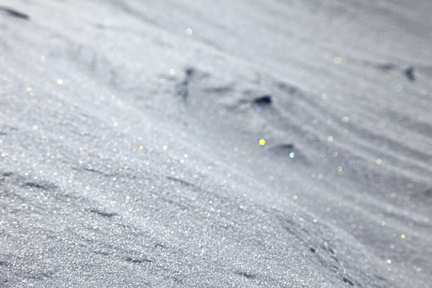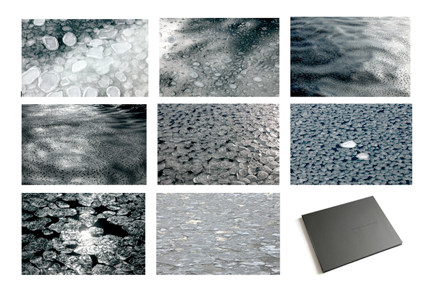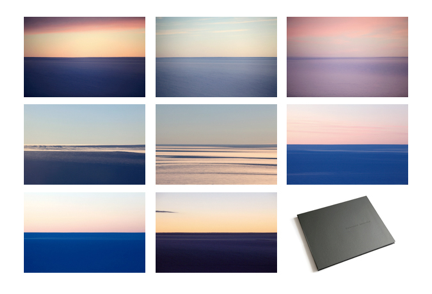THE POLAR PROJECT & ANTARCTICA
- Published: Wednesday, January 14 2015 01:05

Erika Blumenfeld
Title: Untitled (Antarctica, 30 January 2009, 16:51:41 GMT)
Date: 2009
Medium: Archival digital pigment print
Size: 40x60 inches (101.6 x 152.4 cm)
Description: In January 2009, Blumenfeld was invited to Antarctica for a six-week artist-in-residence. Living and working on Earth’s southernmost continent amidst the vast ice fields, luminous glaciers, ancient rock mountains, and the ice-covered sea, Blumenfeld created several new bodies of photo and video-based works. The images depict the natural phenomena of the Antarctic landscape, and portray rarely seen details and patterns of Antarctica’s ephemeral nature.
During my time at the McDonald Observatory, my artistic direction took a radical turn. Night after night, looking up at the universe through the intensely dark and unpolluted sky, I considered how few people around the world have the opportunity to look up and see the stars, planets and constellations so clearly and be witness to their profound beauty. These thoughts led me to reflect on the historical versus contemporary relationship between our natural environment and our civilization. While our technologies have, stunningly, allowed us to see into the microcosm of our bodies and the macrocosm of our universe, we are facing a moment where our technologies are also aiding in certain destabilizing effects to our earth, our water and our air.
The stark polarity of positive and negative attributes intrinsic to technological advancement is a compelling place for me as an artist to begin exploring humanity’s relationship to Earth’s environment. If one lives in a rural area on Earth, one might experience the amazing daily expression of the sky as a place from which to begin to understand the world and behold its treasures and its tragedies. In urban areas of the Earth, however, the subtle shifts in sunlight and moonlight and the ever-changing sky may go unnoticed as lifestyle paces quicken, as pollution modifies our atmosphere, and as the once night skies are imbued with artificial light. In August 2007, I read in The New Yorker that in the time of Galileo the Milky Way was so bright in our then unpolluted skies that it would literally cast a person’s shadow onto the ground—how much things have changed! I came to realize that my love of our natural environment made it impossible for me to continue to make art without also addressing the environmental concerns we are currently facing globally.
Since the autumn 2004, I have been pursuing a profoundly different approach to my art-making practice. In 2005, I initiated The Polar Project, is a series of large-scale environment-focused artworks that document the environment of the Arctic and Antarctica. Arguably the two most fragile, if severe, places on Earth, the Arctic and Antarctica are crucial to humanity’s future and Earth’s stability. Continued anthropogenic climate disruption and glacial melting will affect vast numbers of people worldwide bringing unprecedented challenges to all of humanity. Yet, the remoteness of the North and South Polar Regions means that very few people have access to the Polar environment, and therefore most of Earth’s population have never experienced its remarkable nature.
In late January 2009 I went to Antarctica as the artist-in-residence and official team member of the Interpolar Transnational Art Science Constellation (ITASC) and the guest of the South African National Antarctic Program (SANAP), and lived atop a nunatak (rock mountain) in the Ahlmann Ridge Range in the Queen Maud Land area of Eastern Antarctica, 100 miles from the continent’s ice shelf. During my residency, I created several new bodies of work including installations from the ongoing series Light Recordings, as well as new lens-based video pieces and photographs which are the initial works of The Polar Project.

Erika Blumenfeld
Title: Antarctica Vol. 1 (Early Sea Ice)
Date: 2009
Medium: Suite of 8 archival digital pigment prints housed in an embossed handmade portfolio box
Size: Paper size: 22 x 17 inches each (55.9 x 43.2 cm); Image size: 13.5 x 9 inches (34.3 x 22.9 cm)
Description: The Early Sea Ice volume depicts the Southern Ocean beginning to freeze at the edge of the Antarctic ice shelf. These images mark the moment in Antarctica’s seasonal change between the waning austral summer and the quickly approaching autumn. The sea portrayed here froze overnight, beginning its yearly transition back to the thick ice that encompasses the continent in winter. As the temperature of the ocean begins to drop, the surface water, which has less salinity, freezes first. Since the ocean is never still, the newly forming ice knocks about gently on the surface waves, bumping into other bits of forming ice. The persistence of the motion means that the ice plates are always colliding into one another, eroding each other’s edges. This results in their round shape, called pancake ice. By winter, the sea ice where these images were taken would be around five feet thick.

Erika Blumenfeld
Title: Antarctica Vol. 2 (Land Ice)
Date: 2009
Medium: Suite of 8 archival digital pigment prints housed in an embossed handmade portfolio box
Size: Paper size: 22 x 17 inches each (55.9 x 43.2 cm); Image size: 13.5 x 9 inches (34.3 x 22.9 cm)
Description: The Land Ice volume depicts various formations of surface ice that occur on the continent of Antarctica as a result of the incredible force of the wind. Catabatic winds, as they are called, blow out from the large, elevated ice sheets toward the sea. The buildup of high density cold air over the ice sheets, combined with high elevation brings enormous gravitational energy, which propels the winds to incredible speed, sometimes surpassing even hurricane force. The catabatic winds carve a deep incurvation at the base of the nunataks (rock mountains) as they blow around them, forming ice walls that are upwards of fifty feet high. Like a moat, the wind scoops surround these majestic rock castles, leaving a frozen lake at the bottom in hues of the lightest blues, and rippled like the surface of water. These images were taken inside the wind scoop at the base of Vesleskarvet, a nunatak at the northeastern edge of the Ahlmann Ridge Range in the Queen Maud Land area of Antarctica. They portray the rippling and bubbling of the frozen lake on the floor of the wind scoop, as well as the wind’s carving of the surface of the towering ice walls.

Erika Blumenfeld
Title: Antarctica Vol. 3 (Ice Horizons)
Date: 2009
Medium: Suite of 8 archival digital pigment prints housed in an embossed handmade portfolio box
Size: Paper size: 22 x 17 inches each (55.9 x 43.2 cm); Image size: 13.5 x 9 inches (34.3 x 22.9 cm)
Description: The Ice Horizons volume, an homage to Hiroshi Sugimoto’s seascapes, portrays the brilliant color phenomena that occur when sunlight interacts with the vast Antarctic ice fields. These images depict the fields of ice on the northeastern periphery of the Ahlmann Ridge Range in the Queen Maud Land area of Antarctica. This immense body of ice, which extends toward the edge of the horizon in every direction, can be thousands of feet thick. With ice particulate blowing constantly in the wind across the snow and ice covered ground, virtually everything in this landscape is a refracting surface, waiting to scatter and bend light. Antarctica literally holds light within it. As sunlight moves slowly throughout the environment here, it shimmers across and beneath the ice and snow, illuminating the horizon with vibrant color combinations.
My expedition to Antarctica brought a world before my eyes that was at once luminous, mutable and challenging. To experience its extraordinary nature, one grasps at words and images as if they are tethers to some known understanding. Though the continent in truth eludes all traces of itself, the human imaginings of it are in fact crucial to its survival—we now hold the health of Earth’s ice caps in our hands. As humans, we learn through personal experience: it is how we gain knowledge and insight, and what motivates us to cultivate informed choices. An experience with the Polar Regions would result in a sense of connection with, and greater understanding of, their unique and rare environment and their subsequent vulnerability to climate disruption. The Arctic and Antarctica are a part of our cultural and world heritage, and my intention with The Polar Project is to capture the natural phenomena of these precious regions and preserve their image and voice for future generations.
Over the course of my art practice I’ve learned that every work’s trajectory has its own timeline. The challenges of working on a large-scale project at the ends of the Earth have meant that The Polar Project has necessarily continued to evolve and develop over a ten-year period. The ultimate vision of the project has yet to be realized, although I am ever hopeful that it will one day come to fruition. Yet, the initial phase already has certain voice. Recent book publications that feature the initial works from The Polar Project include Arte da Antarctica (Goethe-Institut, 2009), Art and Ecology Now (Thames & Hudson, 2014), and Klima Kunst Kultur (Steidl, 2014). My essay, “What is White” from my expedition writings is published on the Goethe-Institut’s website for Culture and Climate Change. Additional writing from my journey can be read on my expedition blog.
 Erika Blumenfeld (b. 1971, USA) is an internationally exhibiting transdisciplinary artist and Guggenheim Fellow with a BFA from Parsons School of Design and an MSc from University College London. Since 1998, Blumenfeld’s work has been concerned with the wonder of natural phenomena and our relationship with our natural environment. Approaching her work like an ecological archivist, Blumenfeld has chronicled a range of subjects, including atmospheric and astronomic phenomena, bioluminescent organisms, the polar regions, wildfires, and the natural night sky. In each series, the artist investigates the simple beauty and complex predicament of our environment and ecology, working with scientists and research institutions such as the Scripps Institution for Oceanography, the McDonald Observatory, the South African National Antarctic Program and NASA.
Erika Blumenfeld (b. 1971, USA) is an internationally exhibiting transdisciplinary artist and Guggenheim Fellow with a BFA from Parsons School of Design and an MSc from University College London. Since 1998, Blumenfeld’s work has been concerned with the wonder of natural phenomena and our relationship with our natural environment. Approaching her work like an ecological archivist, Blumenfeld has chronicled a range of subjects, including atmospheric and astronomic phenomena, bioluminescent organisms, the polar regions, wildfires, and the natural night sky. In each series, the artist investigates the simple beauty and complex predicament of our environment and ecology, working with scientists and research institutions such as the Scripps Institution for Oceanography, the McDonald Observatory, the South African National Antarctic Program and NASA.
Blumenfeld has exhibited widely in the US and abroad, including Albright Knox Art Gallery (Buffalo, New York), TATE Modern (London), Fondation EDF Espace Electra (Paris), and Kunstnernes Hus (Oslo, Norway). She has received grants from Creative Capital Foundation and The Polaroid Collections, and artist-in-residences with Cape Farewell (Scotland), with SANAP/ITASC (Antarctica), and Ballroom Marfa (Texas). Blumenfeld has been featured in Art In America, ARTnews and more than a half dozen books, including The Polaroid Book (Taschen 2005 & 2008), Arte da Antarctica (Goethe-Institut, 2009) and Art and Ecology Now (Thames & Hudson, 2014). Her works are in the permanent collections of Albright-Knox Art Gallery, Lannan Foundation, Houston Museum of Fine Arts, New Mexico Museum of Fine Arts, Scottsdale Museum of Contemporary Art, and University of Texas.
For more information, please visit the artist’s website: www.erikablumenfeld.com








Comments